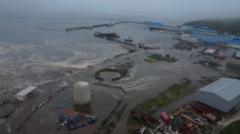The world witnessed a significant geological event today as an 8.8 magnitude earthquake struck near Russia's Kamchatka Peninsula at approximately 11:25 AM local time (00:25 AM BST). This earthquake, one of the most powerful ever recorded, has resulted in tsunami alerts stretching across the Pacific region, prompting urgent evacuation measures in Japan, Russia, and various locations along the US west coast. Additional precautions have been taken in countries like China, the Philippines, Indonesia, New Zealand, and as distant as Peru and Mexico.
Videos circulating on social media depict large waves crashing into buildings in Severo-Kurilsk, Russia, where officials reported flooding affecting ports and fish processing plants, alongside damage to the local power grid in Sakhalin. Japan has mobilized evacuations for roughly 1.9 million individuals, urging them to seek higher ground. In Hawaii, authorities warned of potential 10-foot waves, though Governor Josh Green remarked that no significant wave activity had been recorded yet. Officials expect it will take two to three hours before the situation is adequately assessed for a possible "all clear."
Experts continue to analyze the potential damage, with ongoing adjustments to tsunami forecasts. Chris Goldfinger, a Marine Geology professor at Oregon State University, explained the variability in tsunami impact based on geographical orientation. Areas southeast of the earthquake's epicenter are particularly vulnerable, while the initial energy wave may take about eight to nine hours to reach the US west coast.
The timing of the impending tsunami was highlighted by the US Tsunami Warning system, which predicted waves could reach British Columbia and California around 12:20 AM local time (09:20 AM BST) and Nome, Alaska, at 03:20 AM (12:20 PM BST). Helen Janiszewski, an assistant professor of geophysics at the University of Hawaii, provided insight, noting that tsunami waves travel at speeds comparable to jet aircraft, heralding swift impacts.
This earthquake's depth was relatively shallow, recorded at 19.3 km (12 miles), and it is traced 119 km east-southeast of Petropavlovsk-Kamchatsky. The US Geological Survey noted the earthquake’s magnitude was initially logged at 8.0 but was later revised upwards, with a series of substantial aftershocks reported. Remarkably, this quake now ranks among the six most powerful earthquakes in recorded history, alongside the 2010 Biobío earthquake in Chile and the 1906 Esmeraldas quake in Ecuador. The historical context is stark, especially when placed alongside the 2004 Indian Ocean disaster that claimed over 227,000 lives, underscoring the potentially devastating repercussions of seismic activity in these regions.
Videos circulating on social media depict large waves crashing into buildings in Severo-Kurilsk, Russia, where officials reported flooding affecting ports and fish processing plants, alongside damage to the local power grid in Sakhalin. Japan has mobilized evacuations for roughly 1.9 million individuals, urging them to seek higher ground. In Hawaii, authorities warned of potential 10-foot waves, though Governor Josh Green remarked that no significant wave activity had been recorded yet. Officials expect it will take two to three hours before the situation is adequately assessed for a possible "all clear."
Experts continue to analyze the potential damage, with ongoing adjustments to tsunami forecasts. Chris Goldfinger, a Marine Geology professor at Oregon State University, explained the variability in tsunami impact based on geographical orientation. Areas southeast of the earthquake's epicenter are particularly vulnerable, while the initial energy wave may take about eight to nine hours to reach the US west coast.
The timing of the impending tsunami was highlighted by the US Tsunami Warning system, which predicted waves could reach British Columbia and California around 12:20 AM local time (09:20 AM BST) and Nome, Alaska, at 03:20 AM (12:20 PM BST). Helen Janiszewski, an assistant professor of geophysics at the University of Hawaii, provided insight, noting that tsunami waves travel at speeds comparable to jet aircraft, heralding swift impacts.
This earthquake's depth was relatively shallow, recorded at 19.3 km (12 miles), and it is traced 119 km east-southeast of Petropavlovsk-Kamchatsky. The US Geological Survey noted the earthquake’s magnitude was initially logged at 8.0 but was later revised upwards, with a series of substantial aftershocks reported. Remarkably, this quake now ranks among the six most powerful earthquakes in recorded history, alongside the 2010 Biobío earthquake in Chile and the 1906 Esmeraldas quake in Ecuador. The historical context is stark, especially when placed alongside the 2004 Indian Ocean disaster that claimed over 227,000 lives, underscoring the potentially devastating repercussions of seismic activity in these regions.

















